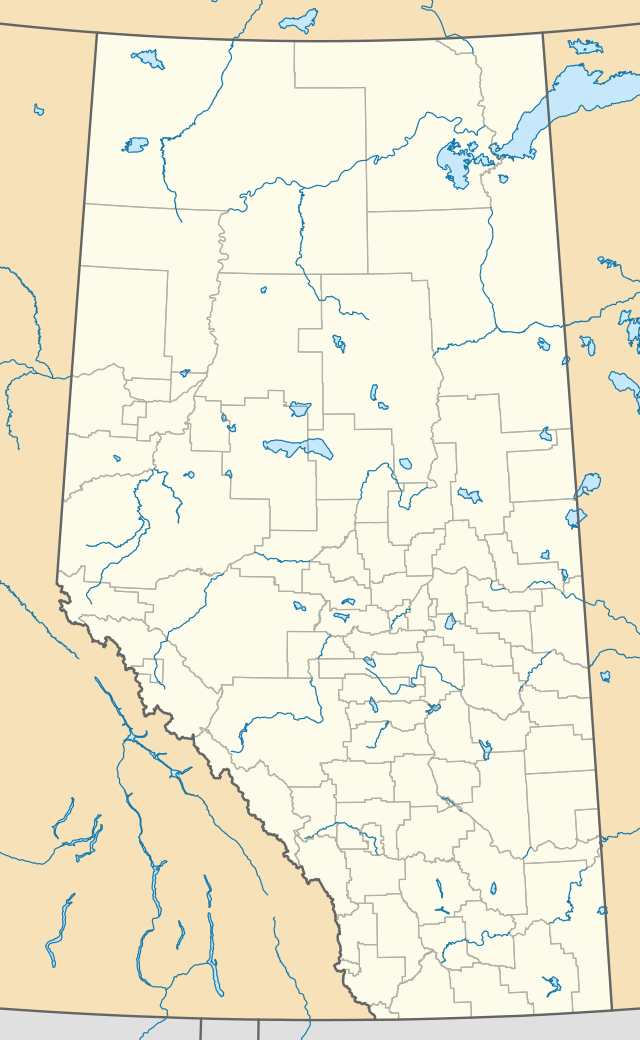Mount Alberta
Mount Alberta is a mountain located in the upper Athabasca River Valley of Jasper National Park, Alberta, Canada. J. Norman Collie named the mountain in 1898 after Princess Louise Caroline Alberta.[1] It is the most difficult of the 11,000ers from a climbing point of view.
| Mount Alberta | |
|---|---|
 Mt. Alberta from Northern edge of Columbia Icefield | |
| Highest point | |
| Elevation | 3,619 m (11,873 ft) [1] |
| Prominence | 819 m (2,687 ft) [2] |
| Listing |
|
| Coordinates | 52°17′14″N 117°28′36″W [3] |
| Geography | |
 Mount Alberta Location in Alberta | |
| Location | Jasper National Park, Alberta, Canada |
| Parent range | Winston Churchill Range |
| Topo map | NTS 83C/05 Fortress Lake[3][4] |
| Climbing | |
| First ascent | July 21, 1925, by a Japanese team (Six Japanese men including Yūkō Maki and three men from Switzerland)[5] |
| Easiest route | rock/snow climb |
Mount Alberta is the fifth-highest peak of the Canadian Rockies[2] and the third highest in Alberta. It is situated 80 kilometres (50 mi) southeast of the town of Jasper, just beyond the Northern extent of the Columbia Icefield. According to the Climber's Guide, Mount Alberta is:
- "One of the finest peaks in the Rockies, a singular uplift that is difficult on all sides."[6]
History
The first ascent was made in 1925 by members of the Japanese Alpine Club: S. Hashimoto, H. Hatano, T. Hayakawa, Y. Maki, Y.Mita, N. Okabe. The team was guided by Hans Fuhrer, H. Kohler and J. Weber, and the leader of the team was Maki. This team consisted of four Keio University alpine club members and two Gakushuin University alpine club members. They started climbing on July 21, 1925. After some difficulty in dealing with an overhang and a steep series of ledges for 16 hours, they reached the top and ceremoniously planted an ice axe.[5] The ice axe was left as a symbol of their achievement. The second party that achieved the ascent found this ice axe 23 years later, and brought it back to the American Alpine Club in New York. The handle of the ice axe had been broken by the ice and rocks. In 1969, the handle was found by a Japanese party, and the two parts were put together in Tokyo in 1997. This ice axe is now exhibited in Jasper Yellowhead Museum.[1]
The second ascent was completed in 1948 by Americans Fred Ayers and John Oberlin. In 1958, the first ascent by a Canadian team was completed by Neil Brown, Hans Gmoser, Leo Grillmair, Heinz Kahl and Sarka Spinkova.[1]
Routes
There are a number of standard climbing routes:[1]
- Japanese Route (Normal Route) V 5.6
- North Face VI 5.9 A3
- North-East Ridge V 5.10
See also
References
- "Mount Alberta". PeakFinder.com. Retrieved 2003-11-07.
- "Mount Alberta". Bivouac.com. Retrieved 2008-05-24.
- "Mount Alberta". Geographical Names Data Base. Natural Resources Canada. Retrieved 2019-09-22.
- "NTS Map 83C05 - Fortress Lake". mec.ca. Retrieved 2019-09-22.
- "Conquering Mount Alberta, 1925". Feature Article. American Alpine Journal. American Alpine Club. 8 (3): 446. 1953. Retrieved 2016-11-11.
- Putnam, William L.; Kruszyna, Robert (1985). Climber's Guide The Rocky Mountains of Canada North. Banff, AB and New York: Alpine Club of Canada and American Alpine Club. p. 127. ISBN 0-930410-19-X.
External links
- Mt. Alberta on SummitPost
- "Mount Alberta". Peakware.com. Archived from the original on 2016-03-04.
Gallery
- Mount Alberta seen from near the summit of Diadem Peak
 Mt. Alberta seen from the Columbia Icefield
Mt. Alberta seen from the Columbia Icefield Mt. Alberta (Ctr) from South Twin summit
Mt. Alberta (Ctr) from South Twin summit